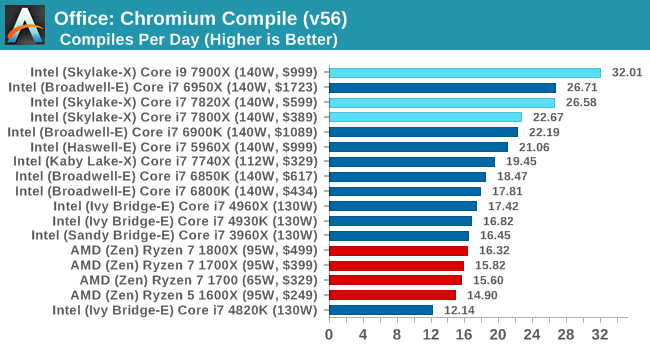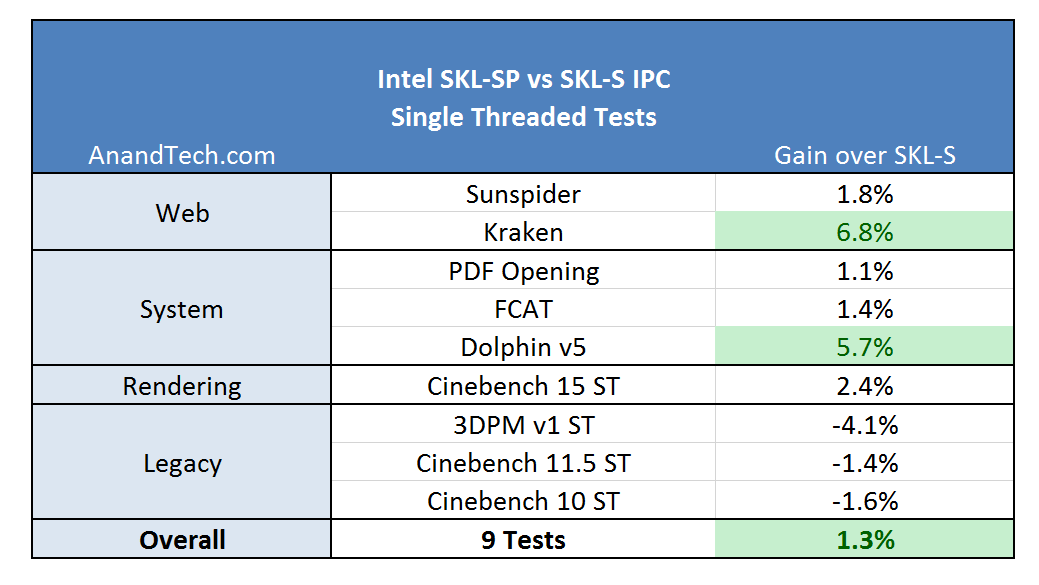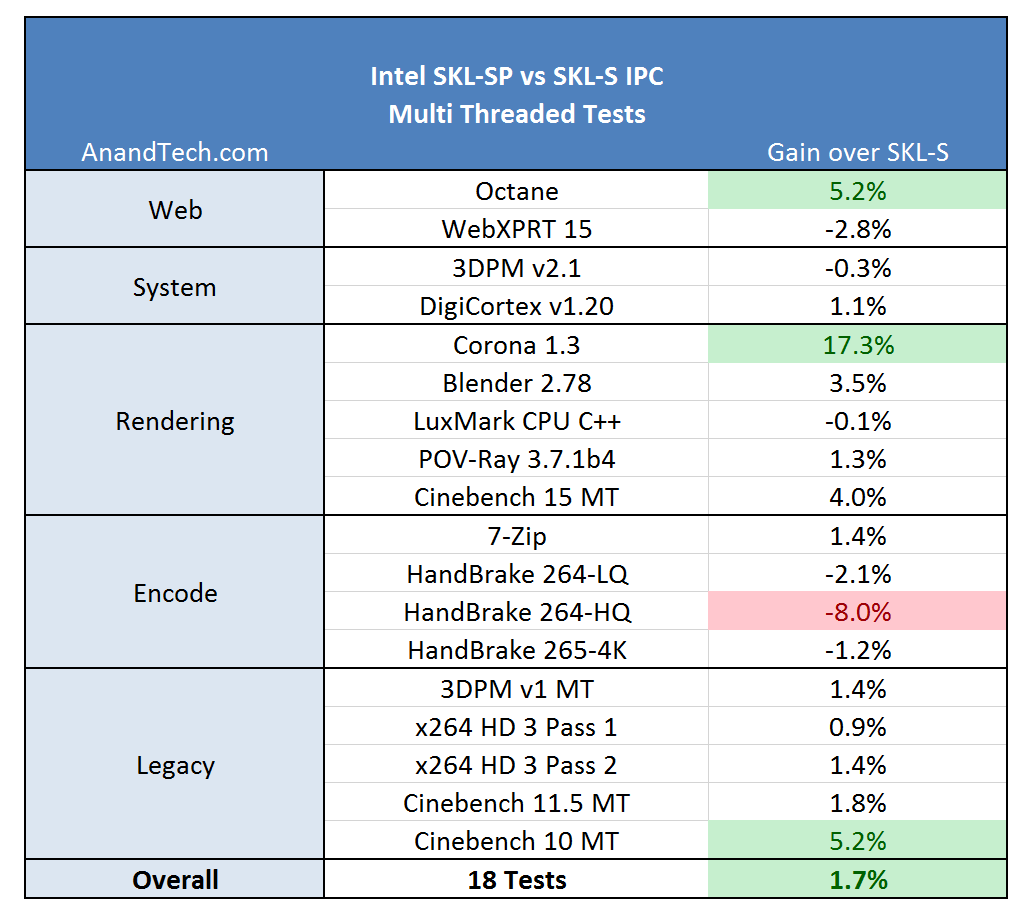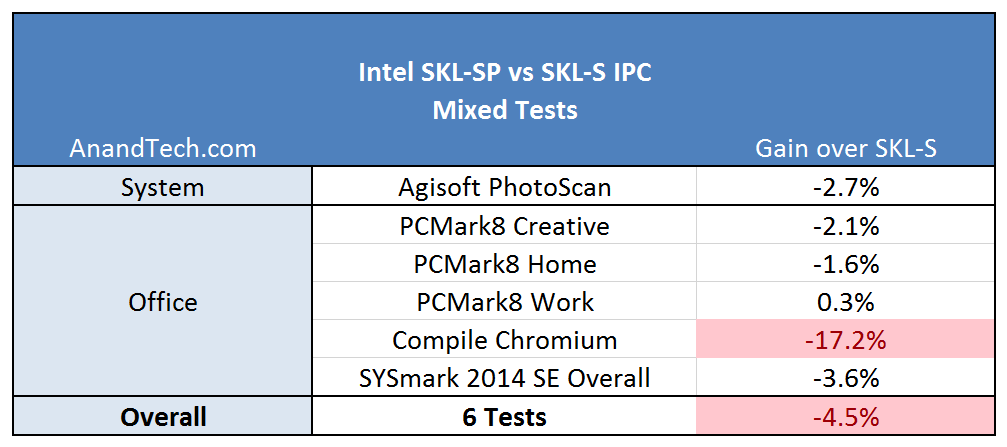The Intel Skylake-X Review: Core i9 7900X, i7 7820X and i7 7800X Tested
by Ian Cutress on June 19, 2017 9:01 AM ESTComparing Skylake-S and Skylake-X/SP Performance Clock-for-Clock
If you’ve read through the full review up to this point (and kudos), there should be three things that stick in the back of your mind about the new Skylake-SP cores: Cache, Mesh and AVX512. These are the three main features that separate the consumer grade Skylake-S core from this new core, and all three can have an impact in clock-for-clock performance. Even though the Skylake-S and the Skylake-SP are not competing in the same markets, it is still poignant to gather how much the changes affect the regular benchmark suite.
For this test, we took the Skylake-S based Core i5-6600 and the Skylake-SP based Core i9-7900X and ran them both with only 4 cores, no hyperthreading, and 3 GHz on all cores with no Turbo active. Both CPUs were run in high performance modes in the OS to restrict any time-to-idle, so it is worth noting here that we are not measuring power. This is just raw throughput.
Both of these cores support different DRAM frequencies, however: the i5-6600 lists DDR4-2133 as its maximum supported frequency, whereas the i9-7900X will run at DDR4-2400 at 2DPC. I queried a few colleagues as to what I should do here – technically the memory support is an extended element of the microarchitecture, and the caches/uncore/untile will be running at different frequencies, so how much of the system support should be chipped away for parity. The general consensus was to test with the supported frequencies, given this is how the parts ship.
For this analysis, each test was broken down in two ways: what sort of benchmark (single thread, multi-thread, mixed) and what category of benchmark (web, office, encode).
For the single threaded tests, results were generally positive. Kraken enjoyed the L2, and Dolphin emulation had a good gain as well. The legacy tests did not fair that great: 3DPM v1 has false sharing, which is likely taking a hit due to the increased L2 latency.
On the multithreaded tests, the big winner here was Corona. Corona is a high-performance renderer for Autodesk 3ds Max, showing that the larger L2 does a good job with its code base. The step back was in Handbrake – our testing does not implement any AVX512 code, but the L3 victim cache might be at play here over the L3 inclusive cache in SKL-S.
The mixed results are surprising: these tests vary with ST and MT parts to their computation, some being cache sensitive as well. The big outlier here is the compile test, indicating that the Skylake-SP might not be (clock for clock) a great compilation core. This is a result we can trace back to the L3 again, being a smaller non-inclusive cache. In our results database, we can see similar results when comparing a Ryzen 7 1700X, an 8-core 95W CPU with 16MB of L3 victim cache, is easily beaten by a Core i7-7700T, with 4 cores at 35W but has 8MB of inclusive L3 cache.
If we treat each of these tests with equal weighting, the overall result will offer a +0.5% gain to the new Skylake-SP core, which is with the margin of error. Nothing too much to be concerned about for most users (except perhaps people who compile all day), although again, these two cores are not in chips that directly compete. The 10-core SKL-SP chip still does the business on compiling:

If all these changes (minus AVX512) offer a +0.5% gain over the standard Skylake-S core, then one question worth asking is what was the point? The answer is usually simple, and I suspect involves scaling (moving to chips with more cores), but also customer related. Intel’s big money comes from the enterprise, and no doubt some of Intel’s internal metrics (as well as customer requests) point to a sizeable chunk of enterprise compute being L2 size limited. I’ll be looking forward to Johan’s review on the enterprise side when the time comes.













264 Comments
View All Comments
Gothmoth - Tuesday, June 20, 2017 - link
especially in the powerdraw and heat class it dominates even my oven....AntDX316 - Tuesday, June 20, 2017 - link
The new processors are in totally another level/league/class. It dominates in everything and more except a couple benches. If you try to compare by price you can't. It would make no sense.Gothmoth - Tuesday, June 20, 2017 - link
it makes sense.. for everyone except stupid fanboys.Hxx - Tuesday, June 20, 2017 - link
so people are getting pissed because these CPUs perform well albet at a much higher price tag. Sounds like a bunch of AMD fanboys.Its new tech, highest performing, and serving a very niche market. Of course is at a premium price. why wouldn't it be? Luckily, these are not needed for the majority so I am not sure why people get so worked up about it. If you want intel then 7700k is a fantasic $300 CPU. If you want AMD then again the 1700 is also a fantastic CPU. end of story
Gothmoth - Tuesday, June 20, 2017 - link
i personally don´t care about price... my PC´s earn the money back i spend.but saying we can´t compare price/performance form skylake-x and ryzen is just plain stupid.
of course we can.
and we can also compare price/performance when threadripper is released... the real competition to x299.
Gothmoth - Tuesday, June 20, 2017 - link
by the way.. what about the RUMORS that coffee lake will be 6 cores... but no hyperthreading?that would be EXACVTLY what i expect from intel.
Intredpid3d - Tuesday, June 20, 2017 - link
Why did you use Intel's compiler for your reviews? with all the other compilers out there that work beautifully with Ryzen why did you use the one that is known to be deliberately coded to work very badly on anything other than its creators products, Intel.?
johnp_ - Tuesday, June 20, 2017 - link
Were did they use Intel's icc? The Chromium compile test was done using VS Community 2015.3.tamalero - Tuesday, June 20, 2017 - link
Thats the interesting thing, in a lot of reviews online.. there are 3 variations of the same test.1) stock I9 7900
2) optimized compiler I9 7900
3) Oced I9 7900
the optimized one yields like 10% higher on average more performance.
johnp_ - Tuesday, June 20, 2017 - link
2) is not possibly for a Chromium compile test, as that has a hard dependency on Visual Studio 2015 U3 and 3) first requires overclocking, for which they didn't have enough time yet.Regarding higher performance, I expect you mean compiled programs reaching higher performance and not the compilation process requiring less time (which is what anandtech measures here and that's the relevant bit for developers).